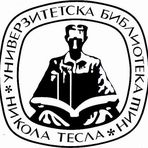Title
Markeri proliferacije i intermedijarnih filamenata u diferencijalnoj dijagnozi benignih i malignih tumora pljuvačnih žlezda
Creator
Živković, Nikola D. 1982-
Copyright date
2016
Object Links
Select license
Autorstvo-Nekomercijalno-Bez prerade 3.0 Srbija (CC BY-NC-ND 3.0)
License description
Dozvoljavate samo preuzimanje i distribuciju dela, ako/dok se pravilno naznačava ime autora, bez ikakvih promena dela i bez prava komercijalnog korišćenja dela. Ova licenca je najstroža CC licenca. Osnovni opis Licence: http://creativecommons.org/licenses/by-nc-nd/3.0/rs/deed.sr_LATN. Sadržaj ugovora u celini: http://creativecommons.org/licenses/by-nc-nd/3.0/rs/legalcode.sr-Latn
Language
Serbian
Cobiss-ID
Theses Type
Doktorska disertacija
description
Datum odbrane: 29.08.2016.
Other responsibilities
mentor
Mihailović, Dragan
predsednik komisije
Jovičić Milentijević, Maja
član komisije
Mijović, Žaklina
član komisije
Pešić, Zoran
član komisije
Tatić, Svetislav
Academic Expertise
Medicinske nauke
University
Univerzitet u Nišu
Faculty
Medicinski fakultet
Group
Katedra za patologiju
Alternative title
Proliferation and intermediate filament markers in the differential diagnosis of benign and malignant tumors of salivary glands
Publisher
[N. D. Živković]
Format
114 listova
description
Beleška o autoru: list 114
description
Pathology
Abstract (en)
Introduction: Salivary gland tumors are rather rare neoplasms characterized by a high level of pleomorphism and histological overlapping. Very often, one tumor may contain several cell types, therefore, it is necessary to include additional histochemical and immunohistochemical staining, as well as the morphometric analysis of tumor cells, in terms of an appropriate diagnosis. Materials and methods: The research encompassed 30 benign and 30 malignant tumors, including pleomorphic adenoma (10), Warthin’s tumor (10), basal cell adenoma (6), myoepithelioma (4), adenoid cystic carcinoma (6), mucoepidermoid carcinoma (8), salivary duct carcinoma (6), polymorphous low-grade carcinoma (6), and myoepithelial carcinoma (4). The expression of Ki67, p53, HER-2, p63, CEA, EMA, S-100, CK14, WT-1, GFAP, αSMA and vimentin was analyzed. The morphometric analysis was performed using “ImageJ” software pack. The area, perimeter, Feret diameter, integrated optical density, nucleus circularity and roundness were analyzed. Results: The Ki67 proliferative index was statistically significantly higher in malignant tumors (p<0.001). Adenoid cystic carcinoma exhibited the highest value, whereas the lowest value was exhibited by basal cell adenoma. Immunohistochemically, pleomorphic adenomas were positive to S-100, GFAP, CK14, αSMA, WT1 and EMA. Warthin’s tumor was positive to CK14, CEA and p63; basal cell adenoma showed positivity to S-100, CEA, and vimentin, whereas myoepithelial tumors were positive to vimentin, GFAP, S100, CK14, αSMA. Adenoid cystic carcinoma exhibited positivity to CEA and S-100, mucoepidermoid carcinoma to CK14, salivary duct carcinoma to EMA, CEA, p53 and HER-2, while polymorphous low-grade carcinoma exhibited positivity to CK14, p63, EMA, S100 and vimentin. The morphometric analysis showed statistically significantly increased values of integrated optical density (p<0.001) and nuclear size parameters (p<0,05) in malignant tumors. The highest values for all parameters were exhibited by salivary duct carcinoma Conclusion: The immunohistochemical analysis was used to determine tumor histogenesis with the aim of differentiation. The Ki67 proliferative index is highly useful in the differentiation of benign from malignant tumors. The morphometric parameters of integrated optical density and nuclear size show statistically higher values in the malignant tumor group.
Authors Key words
Pljuvačne žlezde, benigni tumori, maligni tumori, diferencijalna dijagnoza, imunohistohemija, morfometrija
Authors Key words
Salivary glands,benign tumors, malignant tumors, differential diagnosis, immunohistochemistry, morphometry
Classification
616.316-006.03/.04-079.4-091(043.3)
Subject
B 520
Type
elektronska teza
Abstract (en)
Introduction: Salivary gland tumors are rather rare neoplasms characterized by a high level of pleomorphism and histological overlapping. Very often, one tumor may contain several cell types, therefore, it is necessary to include additional histochemical and immunohistochemical staining, as well as the morphometric analysis of tumor cells, in terms of an appropriate diagnosis. Materials and methods: The research encompassed 30 benign and 30 malignant tumors, including pleomorphic adenoma (10), Warthin’s tumor (10), basal cell adenoma (6), myoepithelioma (4), adenoid cystic carcinoma (6), mucoepidermoid carcinoma (8), salivary duct carcinoma (6), polymorphous low-grade carcinoma (6), and myoepithelial carcinoma (4). The expression of Ki67, p53, HER-2, p63, CEA, EMA, S-100, CK14, WT-1, GFAP, αSMA and vimentin was analyzed. The morphometric analysis was performed using “ImageJ” software pack. The area, perimeter, Feret diameter, integrated optical density, nucleus circularity and roundness were analyzed. Results: The Ki67 proliferative index was statistically significantly higher in malignant tumors (p<0.001). Adenoid cystic carcinoma exhibited the highest value, whereas the lowest value was exhibited by basal cell adenoma. Immunohistochemically, pleomorphic adenomas were positive to S-100, GFAP, CK14, αSMA, WT1 and EMA. Warthin’s tumor was positive to CK14, CEA and p63; basal cell adenoma showed positivity to S-100, CEA, and vimentin, whereas myoepithelial tumors were positive to vimentin, GFAP, S100, CK14, αSMA. Adenoid cystic carcinoma exhibited positivity to CEA and S-100, mucoepidermoid carcinoma to CK14, salivary duct carcinoma to EMA, CEA, p53 and HER-2, while polymorphous low-grade carcinoma exhibited positivity to CK14, p63, EMA, S100 and vimentin. The morphometric analysis showed statistically significantly increased values of integrated optical density (p<0.001) and nuclear size parameters (p<0,05) in malignant tumors. The highest values for all parameters were exhibited by salivary duct carcinoma Conclusion: The immunohistochemical analysis was used to determine tumor histogenesis with the aim of differentiation. The Ki67 proliferative index is highly useful in the differentiation of benign from malignant tumors. The morphometric parameters of integrated optical density and nuclear size show statistically higher values in the malignant tumor group.
“Data exchange” service offers individual users metadata transfer in several different formats. Citation formats are offered for transfers in texts as for the transfer into internet pages. Citation formats include permanent links that guarantee access to cited sources. For use are commonly structured metadata schemes : Dublin Core xml and ETUB-MS xml, local adaptation of international ETD-MS scheme intended for use in academic documents.


